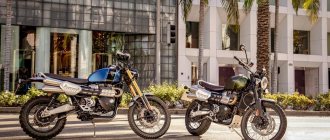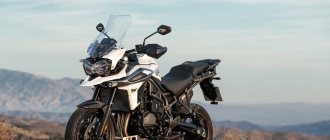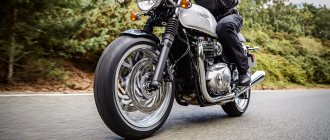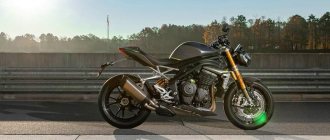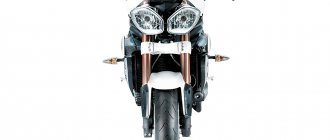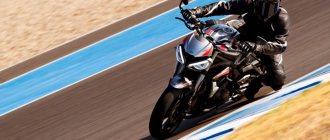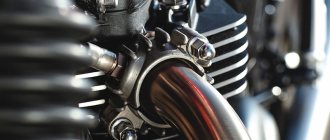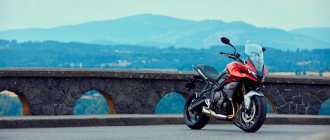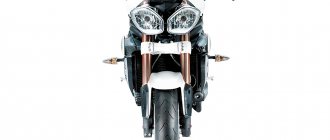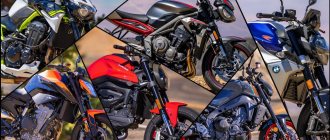The Triumph Street Scrambler made a lot of noise when it hit the market a couple of years ago, and now the manufacturer is launching a new generation for the 2019 model year. Yes, that's right: the SS will receive an update that includes both a change in appearance and a number of electronic improvements that will transform this classic into a thoroughly modern motorcycle. And even that’s not all: the new engine produces 18% more power.
Main technical characteristics of the Triumph Scrambler
Max speed: 180km/h; Frame: steel; Engine: 2 cylinders, DOHC; Volume: 865cm3; Transmission: 5 steps; Power: 58hp; Max.KM: 69 Nm, available already at 5 thousand rpm; Cooling: air; Fuel supply: injector; Drive: chain; Suspension: front – fork, rear – shock absorbers (travel – 120mm); Brakes: front – 310mm disc and caliper, rear – 255mm disc and caliper; Dimensions: 2212x859x1202mm (saddle height – 826mm); Tank: 15.9 l; Weight (with equipment): 230 kg (“dry” – 205 kg).
Spoke wheels, wide steering wheel, solid ground clearance, raised exhaust pipes - the Triumph Scrambler clearly demonstrates what a real two-wheeled, stylish SUV should look like. This is a bike in the style of the brutal 60s: rough blackened steel, a little chrome and no newfangled plastic, a motorcycle that rides calmly even on asphalt, even on a dirt road, even across a field.
CHASSIS, SUSPENSION AND ELECTRONICS
- FRAME Steel tubular frame
- REAR SWIMMER Double-sided steel swingarm
- FRONT WHEEL Spoke wheel, 32 spokes, 19 x 2.5 inches
- REAR WHEEL Spoke wheel, 32 spokes, 17 x 4.25 inches
- FRONT TIRE 100/90 19 Metzeler Tourance
- REAR TIRE 150/70 17 Metzeler Tourance
- FRONT SUSPENSION Cartridge-type fork, stay diameter - 41 mm, travel - 120 mm
- REAR SUSPENSION Two shock absorbers with preload adjustment, rear wheel travel - 120 mm
- FRONT BRAKE Single 310mm floating brake disc, 4-piston Brembo caliper, ABS
- REAR BRAKE Single 255mm disc, Nissin 2-piston caliper, ABS
- INSTRUMENT PANEL Instrument panel with analogue speedometer and analogue tachometer. The instrument panel displays: gear indicator, odometer, two trip meters, service indicator, mileage on the tank, fuel level in the gas tank, average and instantaneous fuel consumption, clock, status of heated handlebars, status of the stability control system and motorcycle operating modes.
Features of Scrambler
The powerful, fairly heavy unit is surprisingly easy to operate. The engine is integrated into the power frame, so the frame has become stiffer, which has significantly improved the behavior of the motorcycle on the track. The seating position is upright, comfortable, the center of gravity is high, the footpegs are raised. The result is complete control over the road situation and no fatigue on long-distance trips. And thanks to the wide handlebar, at low speeds the bike is much more maneuverable than many of its classmates.
That is, the “Scrambler” is a motorcycle specifically for those who value comfort and classics, cross-country ability, power and ease of control. There is no 6th gear, no roar of the engine at 14K rpm, but there is reliability, confidence and practicality. And external recognition.
The brakes grip well and provide clear feedback. The installation of single discs is a little confusing, but it is better than the classic drums used on many road cars. The panel is analog and does not shine with variety; the only instruments on it are the speedometer.
Engine
The main part of the update is changes to the engine.
The main part of the update is changes to the engine. There's something incredibly appealing about wild, unbridled power, and an extra (roughly) 10 horses is undoubtedly great news. Power rose to 64.1 horsepower from the crankshaft , and because some of the engine's internal components were lightened for the 2021 model, the redline was raised by 500 rpm to 7,500 rpm. Peak torque, available from a low 3200rpm, is 80Nm, which is plenty enough to give the Street Scrambler's 202kg (dry) weight a refreshing burst of pep.
The engine with one lightweight camshaft and four valves per cylinder has a total volume of 900 cubic meters. E-throttle and twin throttle bodies control the water-cooled inline-twin, all running under Triumph's high-end engineering wizardry.
Firstly, you have a choice between two driving modes - Road and Rain - allowing you to tailor the engine response to suit the driving conditions. Next, switchable traction control helps keep the rear wheel from locking up when accelerating, and a slipper clutch prevents excess engine-to-wheel torque transfer during engine braking, so you're protected both when accelerating and braking. The five-speed gearbox transmits torque through a simple and reliable chain drive.
Custom Triumph Scrambler
Major collectors from all over the world have been chasing Triumph motorcycles for a long time. The Triumph Scrambler model is no less desirable than the sensational Bonneville. Literally 10 years ago everyone was talking about the end of the era of cafe racers, but contrary to all speculation, a real “renaissance” of these bikes has arrived. Their silhouettes are replete with many fashion magazines; hundreds of photo shoots of completely different directions are not complete without including “iron horses” of this class in the plot.
This custom bike is presented by the Ton-Up Garage salon. Major changes affected the engine, which added an air elimination function, as well as an exhaust pipe. A Zard brand pipe was supplied. New speedometer, headlight and forks. That's basically it. Here is a reanimated bike that has not lost any value due to modifications from the famous motorcycle salon. Quite the opposite.
Roadsters and sports bikes
Trident 660
Added back in 2021, the Trident 660 brings a more affordable entry-level model to Triumph's roadster line-up. 660 cc engine with 81 hp. and a torque of 64 Nm, provides sharp cornering with sufficient power throughout the entire rev range. And, of course, it looks dynamic.
- Base price: 8000 $.
Street Triple
The Triumph Street Triple is considered one of the best middleweight bikes in the market. Thanks to the newly developed 765 cc three-cylinder engine. cm, which is also used as a powerplant for Moto2. The Street Triple is more capable and fun to ride than ever. The Street Triple produces 78 Nm of torque and comes with various riding modes, TFT display, traction control and ABS.
- Versions: Street Triple R, Street Triple RS
- Base price: 10800 $.
Speed Triple
Big brother to the Street Triple, the Speed Triple gives riders a more powerful 1050cc engine. cm, which produces an incredible 147 horsepower and 116 Nm of torque. The Street Triple's styling matches that of its little brother and features a beautiful TFT display, various riding modes, traction control, ABS and Cornering ABS.
- Versions: Speed Triple S, Speed Triple RS
- Base price: 14 350 $.
Speed Triple 1200RS
For some people, there is no such thing as too much power. For such people who buy Triumph, there is the Speed Triple 1200. The engine is 1160 cc. cm, developing 177 hp. and 125 Nm of torque means it can outperform the 1050 cc model. cm... but at the same time it is lighter.
- Base price: 18 300 $.
Rocket 3
The motorcycle equivalent of Samuel L. Jackson saying "Hold on to your ass," the Rocket 3 is just a 2,500cc three-cylinder engine. cm. In fact, it is the largest motorcycle engine in the world. 165 horsepower and 221 pound-feet mean it lives up to its name even when you twist the throttle.
- Versions: Rocket 3 R, Rocket 3 R Black, Rocket 3 GT, Rocket 3 GT Triple Black.
- Base price: 22 500 $.
You can buy motorcycle tires at the Euro-diski store. Large selection and delivery throughout Russia .
Go to the store
Cafe racers
Street Twin
The Triumph Street Twin is one of the best selling Triumph motorcycles. It is also the most popular among female riders, according to Triumph. Powered by a 900cc Triumph engine that produces 64bhp of power and 80Nm of torque, the Street Twin is considered one of Triumph's entry-level entry-level motorcycles.
- Versions: Street Twin, Street Twin Gold Line
- Base price: 9400 $.
Speed Twin
The Triumph Speed Twin brings the modern custom style and ergonomics of the Triumph Street Twin along with stunning finishes and details, all the DNA and comfort of the Bonneville T120, while the power and performance of 96 horsepower, 112 Nm from the 1200 cc engine is plenty for the city. The Street Twin is a modern classic for those looking for power and comfort in one stunning package.
- Base price: 12 200 $.
Thruxton RS
The Thruxton RS is a great looking café racer, featuring a 1200cc parallel twin producing 97bhp. and 112 Nm torque. Low handlebar clip-ons, inverted forks and rear tail add style.
- Base price: 16 200 $.
Cruisers
Speedmaster
The Triumph Speedmaster uses power from a 1200cc engine that produces 76 horsepower and 105 Nm of torque. The Speedmaster offers riders relaxed riding ergonomics such as front footpegs, wide bars and a comfortable seat, while delivering an unforgettable cruiser experience with timeless, sophisticated style.
- Base price: 13 150 $.
Bonneville Bobber
The Bonneville Bobber is a stripped-down cruiser that looks more like a custom bike than a production motorcycle. Featuring Triumph's legendary unique adjustable single floating saddle and Triumph 1200cc parallel twin. cm, developing 76 horsepower and 105 Nm of torque, the Bobber is a distinctive modern motorcycle with classic roots. The Bobber also includes switchable ABS and traction control, two ride modes, ride-by-wire, cruise control, torque-assist clutch and LED lighting front and rear.
- Base price: 13 150 $.
History of the scrambler
Although it is difficult to pinpoint an exact time or place, many agree that scramblers originated in England. Around the 1920s, motorcycles had only been around for a few decades and were just beginning to evolve into custom designed machines, purpose built from the ground up, rather than bicycles that were powered by a primitive, slightly modified engine. The concept of a purpose-built production off-road motorcycle was still on the horizon for nearly half a century, although early riders were nonetheless eager to get off the road and into dirt and off-road riding.
Enthusiasts organized early off-road races and gave participants only the starting point, azimuth and finish. How the rider would get there or how he chose to overcome the obstacles and terrain along the way was entirely up to him. To compete in these events, drivers had to use production models that were built for street use, as, again, there really was no alternative at the time. To make their rides more off-road friendly, riders stripped their bikes down to their bare essentials and often beefed them up to better withstand the rigors of off-road conditions.
Initially, these cars were mostly built in garages by enthusiasts without any help or support from the manufacturers. Eventually, these customs and the local races they competed in became popular. Attracting the attention of various large companies, including manufacturers of spare parts, as well as chassis and engineering equipment.
By the 1960s, manufacturers began producing production scrambler models that were sought after for their off-road capabilities while still being suitable for regular street riding. And right from the exhibition hall you could go off-road. But in reality they were still, for all intents and purposes, street bikes, with modified performance.
By the 1960s, manufacturers began producing scramblers of their existing models. For example, Honda introduced several iconic versions of its bikes, although instead of being marketed under the CB (or "City Bike") designation, these Japanese models were nicknamed "CL" - off-road-ready motorcycles ranging in displacement from 49 to 450 cc. cm. And although they had tall pipes, wide handlebars and all that jazz, they were still heavy cars that were not particularly suitable for hardcore off-road driving.
